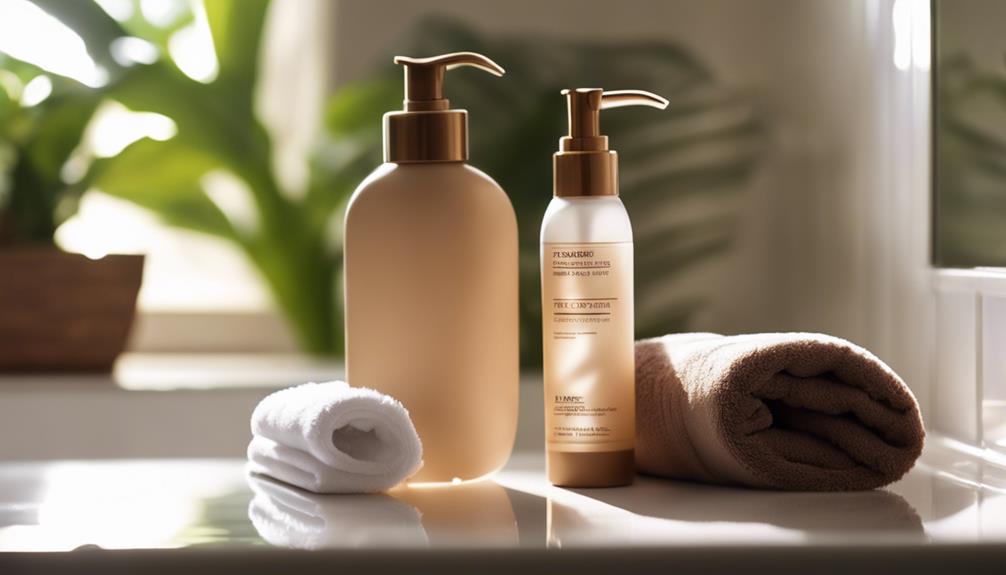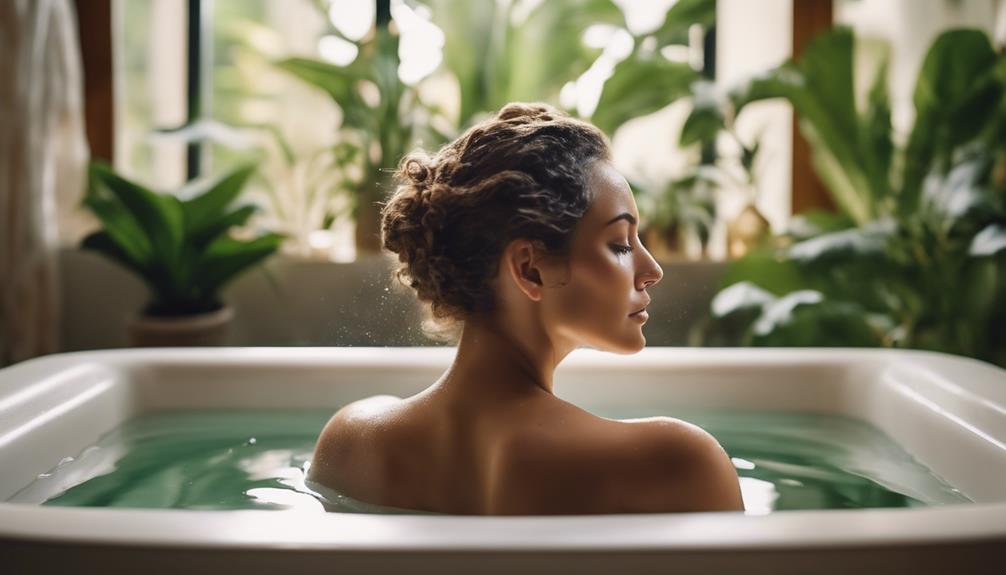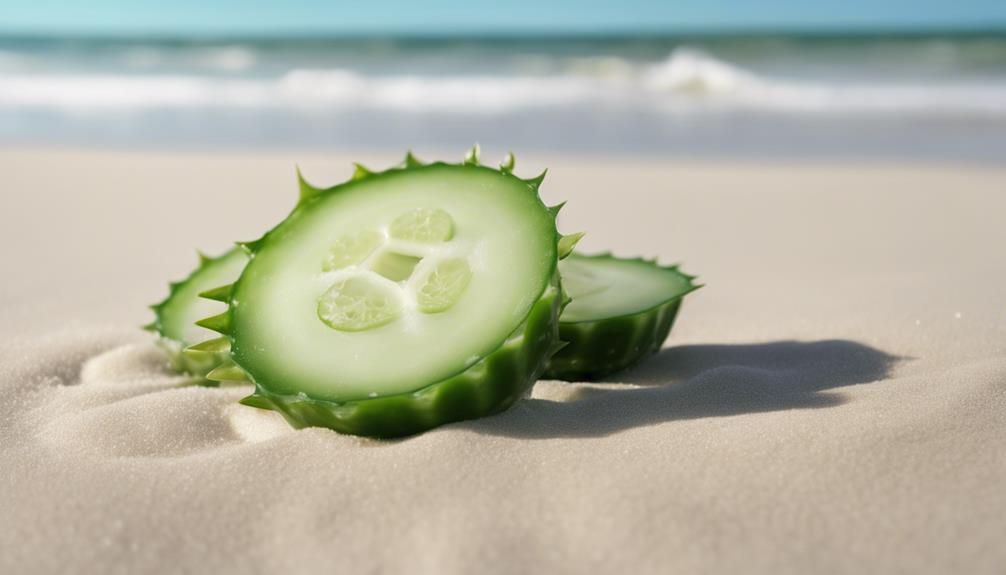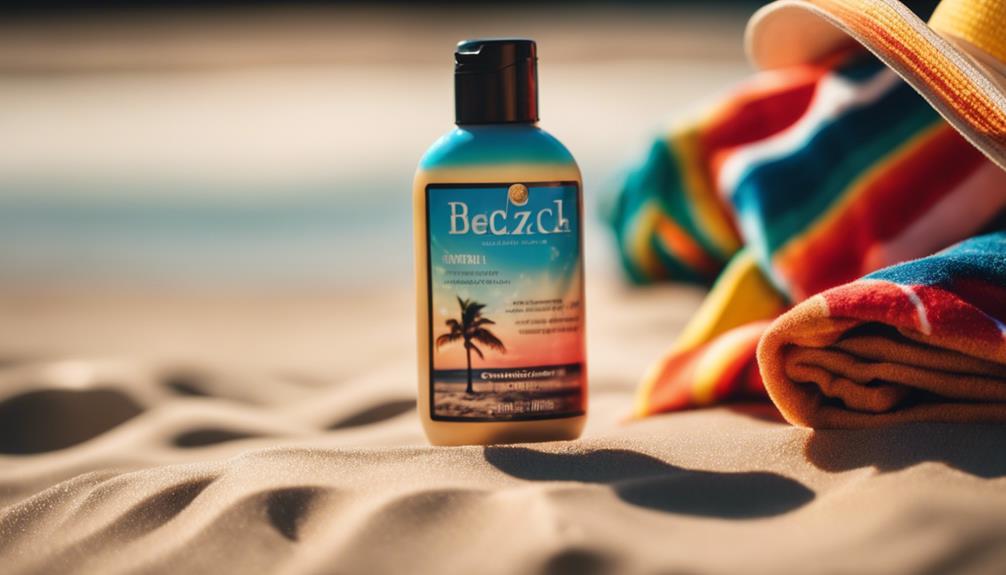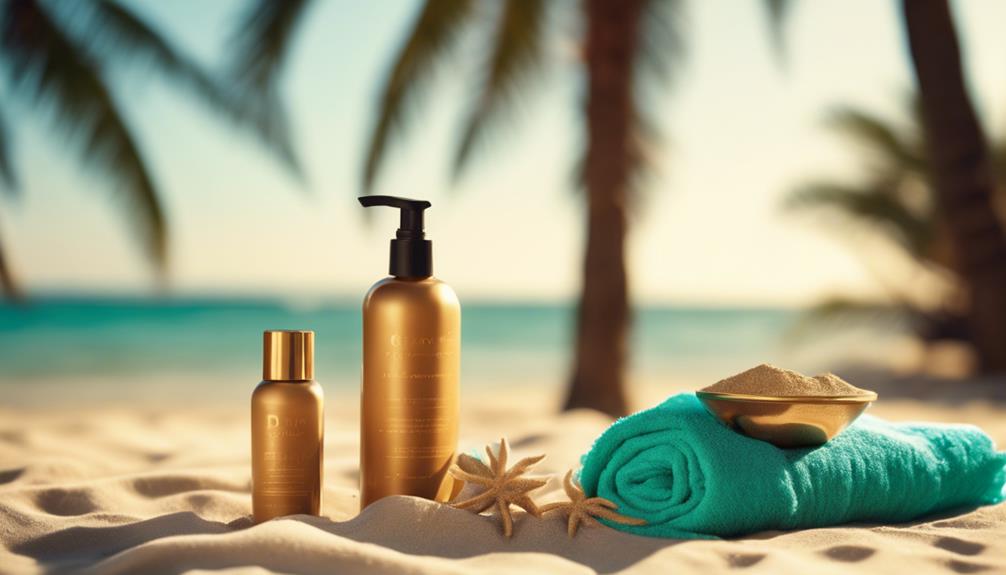Tanning beds aren't safe, and using them exposes you to serious health risks. They primarily emit UVA rays, which can cause cumulative DNA damage and considerably increase your chances of developing skin cancers like melanoma. Studies show that using tanning beds before 35 can elevate your melanoma risk by up to 75%. Regular use can also lead to premature aging, resulting in wrinkles and sagging skin. Plus, many myths surround tanning beds, like the idea of a “safe” tan or vitamin D production, but they're misleading. Stay informed about the real risks and alternative options that keep your skin healthy.
Key Takeaways
- Tanning beds increase the risk of skin cancers, including melanoma, particularly when used before age 35.
- All UV exposure, including from tanning beds, causes cumulative skin damage and accelerates aging.
- Misconceptions persist that tanning beds provide a "safe" tan or vitamin D, but they primarily emit harmful UVA rays.
- Safe alternatives like sunless tanning products and professional spray tans eliminate UV exposure while providing a tanned appearance.
Health Risks of Indoor Tanning
Indoor tanning poses significant health risks, including an increased likelihood of skin cancers and accelerated skin aging. Tanning beds emit UV rays that can cause cumulative DNA damage, putting you at a higher risk for various skin cancers, such as melanoma and basal cell carcinoma. Using tanning beds before age 35 can increase your risk of melanoma by up to 75%, a staggering statistic that underscores the dangers associated with indoor tanning.
Moreover, the risks don't stop at skin cancer. Regular use of tanning beds can lead to premature skin aging, making your skin appear wrinkled and leathery much earlier than it would otherwise. You may also face an increased risk of squamous cell carcinoma, which rises by 58% with tanning bed use.
Eye damage is another serious concern, as tanning salons often fail to emphasize the importance of protective eyewear. Without it, you could suffer from conditions like cataracts or photokeratitis.
Mechanism of Tanning and UV Exposure

Tanning beds primarily emit UVA rays, which penetrate deeper into your skin and markedly contribute to the risk of skin cancer. When you use a tanning bed, the intense UV exposure causes genetic damage to your skin cells. Your body responds by producing melanin, the pigment responsible for tanning. However, this process isn't without consequences. Each tanning session adds to cumulative skin damage, increasing your likelihood of developing various skin cancers, including melanoma.
The intensity of UV exposure in tanning beds can be 10-15 times stronger than natural sunlight, amplifying both immediate and long-term effects. As you continue to tan, you might notice not only a change in skin tone but also signs of premature aging, such as wrinkles and age spots.
Remember, there's no safe level of UV exposure. Whether it's from tanning beds or the sun, any exposure can lead to significant harm to your skin health.
Ultimately, while you might enjoy the look of a tan, it's essential to take into account the serious risks associated with frequent tanning bed use. Protecting your skin should always be a priority.
Statistics on Indoor Tanning Usage

Every year, around 30 million people in the U.S. choose to use tanning beds, revealing just how common indoor tanning has become. Among these indoor tanners, a striking 70% are female users, showcasing a significant gender disparity in tanning bed usage.
The trend is especially concerning among young adults; about 37% of individuals aged 18-29 report using tanning beds. This highlights a growing acceptance of UV radiation exposure within this demographic. Alarmingly, approximately 10% of high school students admit to utilizing indoor tanning facilities.
Early exposure to UV radiation can dramatically increase the risk of skin cancer later in life, making these statistics particularly worrisome. Although increased public awareness and education efforts have contributed to a decline in indoor tanning usage in recent years, many still underestimate the health risks associated with tanning beds.
Alternatives to Indoor Tanning

If you're looking for safer tanning options, there are plenty of alternatives to indoor tanning that can give you that sun-kissed glow.
Sunless tanning products, professional services, and gradual moisturizers allow you to achieve a tan without harmful UV exposure.
Just remember to use sunscreen alongside these products to keep your skin healthy and protected.
Safe Sunless Tanning Options
Exploring sunless tanning options provides a safe way to achieve a beautiful glow without the risks of indoor tanning. Unlike tanning beds, which expose you to harmful UV rays, safe sunless tanning products deliver a temporary tan without skin damage. Self-tanners, available in lotions, sprays, and gels, are popular choices that can provide an even color without the dangers of UV exposure.
If you're looking for an instant effect, bronzers are perfect for special occasions, giving you a quick boost of color without the need for sun exposure. For a more gradual approach, gradual tanning moisturizers allow you to build a subtle glow over time while keeping your skin hydrated.
If you prefer a professional touch, consider professional airbrush tanning, where experts apply the product for a flawless, natural-looking tan.
However, it's essential to remember that self-tanners don't offer sun protection; always apply sunscreen when spending time outdoors, even after using these products. By opting for safe sunless tanning methods, you can enjoy a radiant look while prioritizing your skin's health.
Professional Tanning Services
Professional tanning services offer a safe and effective alternative to indoor tanning, allowing you to achieve a beautiful, bronzed look without the harmful effects of UV exposure.
These services include professional spray tans and sunless tanning options that use advanced airbrush techniques to provide an even and natural-looking tan. The specialized formulas can be tailored to match your skin tone, ensuring a stunning result every time.
To maximize the benefits of your professional tanning session, it's important to prepare your skin through exfoliation. This process enhances the results by creating a smoother surface, allowing for better absorption of the tanning solution.
Unlike tanning beds, which can increase the risk of skin cancer, professional tanning services don't expose you to harmful UV rays, making them a safer alternative.
For long-lasting results, consider scheduling regular maintenance sessions. This will help you achieve and sustain your desired tan while steering clear of the health risks associated with indoor tanning.
Importance of Sunscreen Usage
Sunscreen is your best defense against harmful UV rays, whether you're soaking up the sun or enjoying a day indoors. It's vital to protect your skin from both UVA and UVB rays, which can lead to skin cancer and significant skin damage over time.
To guarantee effective protection, choose a broad-spectrum sunscreen with at least SPF 30. Regular application and reapplication every two hours—more often if you're sweating or swimming—are fundamental to maintaining this defense.
If you're seeking a bronzed look without the risks of indoor tanning, consider self-tanners or spray tans. These alternatives allow you to achieve that sun-kissed glow without exposing your skin to harmful UV rays.
While these products won't protect you from UV exposure, they offer a safer way to enhance your appearance.
Advocacy and Public Awareness

Public awareness campaigns are essential in highlighting the dangers of indoor tanning and pushing for stricter regulations to protect youth from harmful UV exposure. Advocacy efforts have led to increased scrutiny of the tanning industry, prompting the FDA to evaluate stricter regulations, including banning tanning bed use for individuals under 18. These initiatives stress that even minimal exposure to tanning beds can have severe health implications, such as an increased risk of skin cancer.
Many states have responded to these calls by enacting age restrictions on tanning bed access, reflecting growing concerns about the risks associated with UV exposure among young people. Unfortunately, a significant number of tanning salon staff continue to deny the health risks, misleading customers about the dangers of indoor tanning.
Through social media and community programs, awareness initiatives aim to educate you on the perils of indoor tanning. They promote healthier alternatives and reinforce the importance of sun safety practices, ensuring that you make informed decisions about your health.
Tanning Beds Vs. Sun Exposure

When comparing tanning beds to sun exposure, it's essential to understand the intensity of UVA rays they emit.
Tanning beds can deliver 10-15 times more UVA rays than natural sunlight, raising your risk of skin damage and cancer.
Both options carry dangers, but the significant difference in UVA exposure highlights the potential hazards of indoor tanning.
UVA Ray Comparison
Tanning beds emit 10-15 times more UVA rays than the sun, making them a significant threat to your skin health. These UVA rays penetrate deeper into your skin, leading to increased skin damage and a higher risk of skin cancer, including melanoma. Whether you're using tanning beds or relying on sun exposure, both methods expose you to harmful UV radiation.
Here are some important points to reflect on:
- Higher Intensity: Indoor tanning accelerates skin aging due to the intense UVA radiation, making your skin appear older faster.
- Increased Melanoma Risk: Starting indoor tanning before age 35 heightens your risk of melanoma by 75%.
- No Safe Level: There's no such thing as a safe level of UV exposure; both tanning beds and the sun can harm your skin.
- Cumulative Damage: Each session, whether in a tanning bed or under the sun, contributes to cumulative skin damage over time.
Cancer Risk Factors
Both tanning beds and sun exposure carry notable cancer risk factors, with indoor tanning often amplifying the dangers associated with UV radiation. Tanning beds emit 10-15 times more UVA rays than natural sunlight, leading to increased skin damage and a higher risk of skin cancers such as melanoma, squamous cell carcinoma, and basal cell carcinoma.
| Cancer Type | Risk Increase with Tanning Beds |
|---|---|
| Squamous Cell Carcinoma | 58% |
| Basal Cell Carcinoma | 24% |
| Melanoma (before age 35) | 75% |
| Women diagnosed (under 30) | 97% used tanning beds |
| Cumulative Skin Damage | No safe level of exposure |
Starting indoor tanning before 35 poses a particularly high threat, as it greatly boosts your chances of developing melanoma. Furthermore, both tanning beds and sun exposure contribute to cumulative skin damage, and there's no established safe level of UV exposure. Being aware of these risks is vital if you're considering indoor tanning as a viable option for achieving a bronzed look. Prioritizing your skin health is essential in the long run.
Risks of Moderate Use

Even moderate use of tanning beds poses significant health risks, with studies showing that just one session before age 35 can increase your melanoma risk by a staggering 75%. You might think that occasional tanning bed sessions are safe, but the reality is that the risks of indoor tanning are serious and cumulative.
Here are some key points to reflect on:
- Each tanning bed session increases your risk of skin cancer, with no safe level of UV exposure available.
- A striking 97% of women diagnosed with melanoma before age 30 reported using tanning beds.
- Indoor tanning can elevate the risk of non-melanoma skin cancers, like squamous cell carcinoma by 58% and basal cell carcinoma by 24%.
- Even sporadic use leads to cumulative skin damage, contributing to premature aging and heightened skin cancer risk over time.
It's essential to be aware of these risks associated with moderate use of tanning beds. Protecting your skin and opting for safer alternatives is the best choice for your long-term health.
Myths About Base Tans

Many people mistakenly believe that developing a base tan can protect them from sunburn, but this notion is misleading and dangerous. A base tan only offers minimal protection, equivalent to an SPF of just 3, which is far from sufficient. This misconception can lead you to seek more UV exposure, increasing your risk of skin damage and skin cancer.
Here's a quick look at the realities of base tans:
| Myth | Truth |
|---|---|
| Base tans prevent sunburn | Base tans provide minimal protection (SPF 3) |
| Tanning beds are safe | Tanning beds damage your DNA |
| Cumulative effects don't matter | Skin damage accumulates over time |
| Base tans reduce cancer risk | Base tans increase skin cancer risk |
| You can “safely” tan | All tanning causes skin damage |
Vitamin D Production Misconceptions

You might think tanning beds are a good way to boost your vitamin D, but that's a misconception.
They mainly emit UVA rays, which don't help with vitamin D production—UVB rays are what you need.
Fortunately, you can easily meet your vitamin D needs through a balanced diet and supplements, without risking your skin's health.
UVA Vs. UVB Rays
Tanning beds primarily emit UVA rays, which fail to stimulate vitamin D production, highlighting a common misconception about their supposed health benefits.
While many people believe that indoor tanning can provide the same benefits as sun exposure, it's essential to comprehend the differences between UVA and UVB rays.
Here are some key points to reflect on:
- Vitamin D Production: UVB rays, not UVA rays, are vital for vitamin D synthesis in your skin.
- Sun Exposure: Minimal sun exposure on your face and hands is usually enough to maintain adequate vitamin D levels.
- Risks of Using Tanning Beds: Excessive exposure to UVA rays from tanning beds increases your risk of skin cancer without greatly boosting your vitamin D levels.
- Public Health Guidelines: Experts recommend obtaining vitamin D through diet and supplements rather than relying on indoor tanning.
Dietary Vitamin D Sources
Understanding the importance of dietary vitamin D sources can help clarify the misconceptions surrounding tanning beds and UV exposure. Many people believe that tanning beds are an effective way to boost vitamin D levels, but this isn't the case. Tanning beds primarily emit UVA rays, which don't promote vitamin D production. Instead, you can safely obtain vitamin D through dietary sources and supplements.
Here's a quick look at some effective dietary sources of vitamin D:
| Food Source | Vitamin D Content (IU) | Health Benefits |
|---|---|---|
| Fatty Fish (Salmon) | 600-1000 | Supports bone health |
| Fortified Milk | 100-120 | Boosts immune function |
| Egg Yolks | 40 | Promotes brain health |
| Vitamin D Supplements | Varies | Guarantees adequate intake |
Public health guidelines emphasize safe exposure to sunlight for vitamin D, recommending minimal sun exposure on your face and hands. Excessive UV exposure, particularly from tanning beds, greatly increases your risk of skin cancer. Prioritizing dietary sources and supplements over tanning beds is key to maintaining healthy vitamin D levels without compromising your health.
Skin Aging and Tanning

Frequent exposure to tanning beds speeds up skin aging, leading to wrinkles and a leathery texture that can make you look older than your years. The UV damage from indoor tanning can result in significant consequences for your skin's health and appearance.
Here are some critical points to reflect on:
- Accelerated Wrinkles: Regular tanning contributes to premature wrinkles, affecting your skin's smoothness.
- Age Spots: You may notice age spots appear earlier as UV exposure damages skin cells.
- Loss of Elasticity: Tanning beds cause your skin to lose firmness and elasticity, making it sag faster.
- DNA Damage: Each session contributes to DNA damage in your skin cells, which can lead to more severe consequences over time.
The cumulative effects of indoor tanning mean you'll likely experience visible signs of aging sooner than someone who avoids it.
On the bright side, quitting tanning can help your skin begin to repair itself, reversing some damage over time. Protecting your skin today means preserving your youthful appearance for tomorrow.
Frequently Asked Questions
Can Tanning Beds Be Safe in Moderation?
You might think tanning beds are safe in moderation, but even minimal exposure can increase your risk of skin cancer. It's best to avoid them altogether for your long-term health and well-being.
Why Is Indoor Tanning Bad for You?
Why risk your skin? Indoor tanning's bad for you because it increases your chances of skin cancer and accelerates aging. Each session adds up, causing irreversible damage that your skin will regret later.
Why Should You Avoid Using a Tanning Bed?
You should avoid using a tanning bed because it greatly increases your risk of skin cancers, accelerates skin aging, and causes harmful DNA damage. There's no safe level of UV exposure, so it's best to stay away.
Are Sunbeds Really Bad for You?
Using a sunbed's like playing with fire; it might feel warm, but it can burn you. Yes, sunbeds are bad for you, increasing serious skin cancer risks and causing long-term damage to your skin.
Are Tanning Beds Safe for Men’s Skin?
When it comes to men’s skincare truth essentials, the safety of tanning beds is a concern. Studies have shown that the UV rays emitted by tanning beds can increase the risk of skin cancer, premature aging, and other skin issues. It’s important for men to prioritize their skin health and consider alternative tanning methods.
Conclusion
In the end, the allure of tanning beds can be as deceptive as a siren's song.
While they might promise a sun-kissed glow, the health risks often lurk in the shadows, ready to pounce.
It's essential to weigh the dangers against the fleeting beauty they offer.
Instead of chasing that tan, consider safer alternatives that protect your skin and health.
Remember, true beauty shines from within, not from a tanning bed.
Choose wisely and glow naturally!

